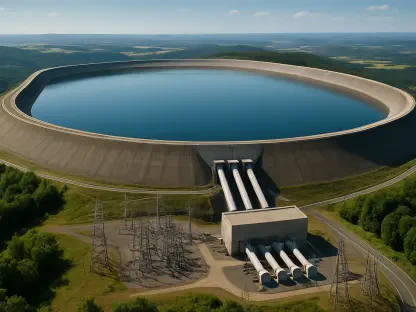The potential repeal of the 45V tax credit, currently under consideration, poses significant questions about the future of blue hydrogen and its related job prospects in the United States. Blue hydrogen, which is derived from natural gas through carbon capture and sequestration, is seen as a promising transitional energy source that both utilizes existing resources and reduces carbon emissions. As legislative discussions unfold, the implications of this shift on domestic job creation, economic growth, and the broader agenda of decarbonizing industries like shipping and heavy-duty manufacturing are prominently at stake. Concerns have risen among stakeholders regarding how this legislative move might hinder the momentum of the burgeoning blue hydrogen industry and push its development away from the U.S., potentially impacting up to 62,200 positions that are currently projected.
Impact on Job Creation and Economic Growth
A key concern surrounding the potential repeal of the 45V tax credit is the profound effect it could have on job creation within the blue hydrogen sector. The Citizens for Responsible Energy Solutions Forum (CRES Forum) estimates almost 9.8 million metric tons of blue hydrogen production capacity is in the pipeline across the United States. This expansive project forecast translates into tens of thousands of jobs—both direct roles in hydrogen production and indirect positions across natural gas, supply chains, and manufacturing sectors. The tax credit has been a motivating factor, offering financial incentives that have attracted investors and companies committed to expanding the industry. If removed, the ripple effect on employment opportunities could be detrimental, pushing stakeholders to consider relocating production to countries with supportive fiscal policies.
The economic ramifications extend beyond individual job losses, threatening the broader economic landscape if the industry fails to thrive domestically. The current positive trajectory is largely fueled by the tax credits, which align with the strategic importance of blue hydrogen in supporting the transition to a low-carbon economy. Losing these incentives may result in outsourcing potential economic growth tied to the infrastructure for blue hydrogen production. This scenario underscores the competition the U.S. will face against other international players who are heavily investing in similar low-carbon technologies. The absence of the tax credit could inadvertently give these nations a competitive edge, as they are actively focusing on capitalizing on their domestic energy resources to produce green and blue hydrogen products.
Strategic Significance of Blue Hydrogen
Blue hydrogen’s strategic value in the U.S. energy landscape cannot be understated. It offers a bridge from traditional fossil fuel dependencies to renewable energies, providing an opportunity to utilize existing natural resources more sustainably. The technology to produce blue hydrogen, bolstered by carbon capture, plays a vital role in national endeavors to cut emissions in high-pollutant sectors such as shipping and manufacturing. The 45V tax credit has been instrumental in ensuring that these technologies remain competitive on a global scale, making the U.S. a leader in energy innovation. Without fiscal support, however, domestic industries may struggle to maintain their footing as international competitors gain ground.
The global market dynamics underscore a broader strategic urgency to maintain and expand the U.S.’s leadership in the blue hydrogen arena. Nations rich in fossil fuels, particularly in the Middle East and China, are well-positioned to convert their abundant natural resources into low-carbon products effectively. The repeal of the tax credit could widen this gap, particularly if these countries offer more attractive incentives, drawing in investments and potentially sidelining U.S. efforts. The significance of blue hydrogen extends to geopolitical considerations, where energy independence and leadership in sustainable technologies are intrinsically linked to economic stability and growth.
Policy and Legislative Considerations
The conversation surrounding the potential repeal of the 45V tax credit is largely framed by the broader legislative context of energy policy in the U.S. Initial bipartisan support suggested a shared commitment to advancing clean energy solutions, yet the current debate reflects underlying political and economic complexities. Legislative timelines and delayed guidance releases, such as those from the IRS, have further complicated the operationalization of tax incentives, making it challenging for stakeholders to capitalize on intended benefits. These dynamics highlight the need for coherent policy frameworks that not only sustain but enhance energy innovation in the U.S.
The policy indecision points to the necessity of strategic alignment between legislative actions and industry needs, particularly for sectors like blue hydrogen that are still in developmental stages. As the U.S. navigates its path toward decarbonization, maintaining a stable and supportive policy environment is crucial. Policymakers are urged to consider the long-term implications such shifts in tax credit strategies may have on innovation, competitiveness, and climate goals. A failure to adequately support these emerging technologies risks not only economic setbacks but also undermines the nation’s climate objectives.
Future Considerations and Industry Implications
The potential repeal of the 45V tax credit raises significant concerns about its impact on job creation in the blue hydrogen sector. The Citizens for Responsible Energy Solutions Forum (CRES Forum) estimates that roughly 9.8 million metric tons of blue hydrogen production capacity is planned across the United States. These ambitious projects could result in tens of thousands of new jobs, directly in hydrogen production and indirectly in the natural gas, supply chain, and manufacturing industries. The tax credit has been essential in encouraging investment and expansion within the sector. If eliminated, it could severely affect employment opportunities, possibly driving companies to relocate production to nations offering better fiscal conditions.
This situation not only threatens individual jobs but could undermine the broader U.S. economy if the domestic blue hydrogen industry falters. The current growth trend relies heavily on these tax incentives, which are pivotal for the transition to a low-carbon economy. Without them, the U.S. might lose economic growth linked to blue hydrogen infrastructure to other countries investing in low-carbon technologies. Such countries could gain an advantage, emphasizing their resources to produce blue and green hydrogen, potentially surpassing the U.S. in this critical energy transition area.









